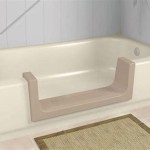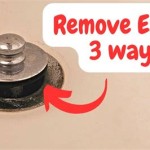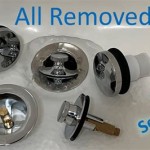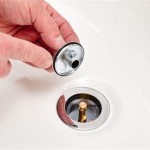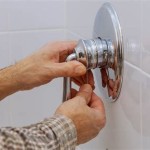Bathtub Right Hand Drain: A Comprehensive Guide
The configuration of a bathtub drain significantly impacts bathroom layout and plumbing considerations. Among the various drain placements, the right-hand drain bathtub is a prevalent option, offering distinct advantages and disadvantages depending on the bathroom's existing infrastructure and design preferences. This article provides a detailed exploration of the right-hand drain bathtub, covering its characteristics, installation nuances, benefits, drawbacks, and factors influencing its suitability for different bathroom scenarios.
A right-hand drain bathtub, as the name suggests, features its drain located on the right side of the tub when facing it. This seemingly simple detail necessitates careful planning during bathroom renovation or new construction. The positioning of the drain dictates the plumbing connections and affects the overall flow and functionality of the bathroom space. Understanding the specific implications of a right-hand drain configuration allows for informed decision-making when selecting a bathtub and designing the surrounding bathroom layout.
The choice between a right-hand and a left-hand drain bathtub isn't merely aesthetic; it directly influences the plumbing setup. The drain connects to the waste and overflow system, which then ties into the main drain line. The positioning of this main drain relative to the bathtub's location is a critical factor. A right-hand drain might be ideal if the existing drain line is situated closer to the right side of the intended bathtub placement, minimizing the need for extensive and costly plumbing modifications.
Understanding the Anatomy of a Right-Hand Drain Bathtub
To fully appreciate the implications of a right-hand drain bathtub, a basic understanding of its components is essential. The bathtub itself is the basin where bathing occurs, typically constructed from materials like acrylic, cast iron, or steel. The drain assembly, located on the right side, consists of several key parts. First, there's the drain flange, a metal ring that sits flush with the tub's surface and provides a secure connection point. Beneath the flange is the drain body, which channels water down into the drainpipe. The drain stopper, or plug, prevents water from escaping. An overflow pipe, usually positioned near the top of the bathtub, prevents the tub from overflowing by diverting excess water into the drain system.
The connection between the drain assembly and the main drain line is achieved through a system of pipes known as the waste and overflow (W&O) system. This system typically includes a curved section of pipe called a P-trap, which traps a small amount of water to prevent sewer gases from entering the bathroom. The W&O system connects to the main drain line, carrying wastewater away from the bathtub and into the sewer system. The configuration and materials used for the W&O system are crucial for ensuring proper drainage and preventing leaks.
The installation of a right-hand drain bathtub requires careful attention to detail. The first step typically involves preparing the subfloor and ensuring that it is level and structurally sound. The drainpipe connection must align accurately with the bathtub drain. The W&O system is then assembled and connected to the drain flange and the main drain line. Leak testing is a crucial step to verify the integrity of all connections before the bathtub is fully installed. Finally, the bathtub is secured in place and the surrounding area is finished with tiling or other decorative elements.
Advantages and Disadvantages of Choosing a Right-Hand Drain
The decision to opt for a right-hand drain bathtub is influenced by several factors. One of the primary advantages is its compatibility with existing plumbing. If the main drain line in the bathroom is located on the right side of the desired bathtub location, installing a right-hand drain bathtub can minimize the need for extensive and costly plumbing alterations. This can result in significant savings in terms of both time and money during a bathroom renovation project.
Another advantage relates to bathroom layout and accessibility. In certain bathroom configurations, a right-hand drain allows for a more efficient use of space. For example, if the toilet is located on the left side of the bathtub, a right-hand drain might facilitate a more comfortable and accessible bathing experience, especially for individuals with mobility limitations. The placement of the drain can affect the overall flow of movement within the bathroom and contribute to a more functional and user-friendly design.
However, a right-hand drain bathtub also presents certain drawbacks. If the existing plumbing is not conducive to a right-hand drain configuration, installing one might require significant plumbing modifications, potentially increasing the overall cost and complexity of the project. Rerouting drain lines can be a labor-intensive process, involving cutting into walls and floors, and might necessitate the involvement of a qualified plumber.
Furthermore, the aesthetic impact of a right-hand drain should be considered. The drain location can influence the overall visual balance of the bathroom. In some cases, a left-hand drain might be more visually appealing, especially if the bathtub is a focal point of the room. While aesthetics are subjective, it's important to consider how the drain placement affects the overall aesthetic harmony of the bathroom design.
Factors Influencing the Choice of a Right-Hand Drain Bathtub
Several key factors should be considered when determining whether a right-hand drain bathtub is the right choice for a particular bathroom. The most crucial factor is the existing plumbing configuration. The location of the main drain line relative to the desired bathtub placement is paramount. If the drain line is located on the right side, a right-hand drain bathtub is likely the most efficient and cost-effective option. If the drain line is located on the left side or in the center, alternative drain configurations should be considered, or the plumbing will need to be altered.
Bathroom layout and dimensions also play a significant role. The size and shape of the bathroom, as well as the location of other fixtures such as the toilet, sink, and shower, will influence the optimal drain placement. In smaller bathrooms, maximizing space efficiency is crucial, and the right-hand drain might provide a more streamlined layout. In larger bathrooms, the drain placement might be less critical, allowing for greater flexibility in design choices.
Accessibility considerations are also relevant, especially for individuals with mobility limitations. The drain placement can affect the ease of entering and exiting the bathtub. A right-hand drain might be more suitable for individuals who prefer to enter the tub from the left side, or vice versa. Consulting with an occupational therapist or accessibility specialist can provide valuable insights into the optimal drain placement for individuals with specific needs.
The type of bathtub being installed also influences the drain configuration. Standard alcove bathtubs, which are typically installed against three walls, offer limited flexibility in drain placement. However, freestanding bathtubs, which are not attached to any walls, offer greater flexibility in terms of drain location. The choice between an alcove bathtub and a freestanding bathtub will impact the options available for drain placement.
Finally, budget considerations are always relevant. Plumbing modifications can be costly, so it's important to factor in the cost of rerouting drain lines when evaluating different drain configurations. Obtaining multiple quotes from qualified plumbers can help to estimate the cost of plumbing modifications and make an informed decision about the most cost-effective option. The initial cost of the bathtub itself also factors into the overall budget. Different materials and features will influence the overall price of the bathtub.
In summary, the selection of a right-hand drain bathtub is a multifaceted decision that requires careful consideration of existing plumbing, bathroom layout, accessibility needs, bathtub type, and budget. By thoroughly evaluating these factors, homeowners and contractors can make informed choices that result in a functional, aesthetically pleasing, and cost-effective bathroom design. The right-hand drain bathtub, when appropriately considered within the broader context of bathroom planning, can be a practical and valuable option.

Kohler Seaforth 54 In X 30 Soaking Bathtub With Right Hand Drain White K 746 0 The Home Depot

Voltaire 54 X 30 Right Hand Drain Alcove Bathtub With Apron Armrest Swiss Madison Well Made Forever

Hydro Systems Ton 54 In Acrylic Right Hand Drain Rectangular Alcove Air Bath Bathtub White Tnt5436ataw The Home Depot

Voltaire 54 X 30 Right Hand Drain Alcove Bathtub With Apron Armrest Swiss Madison Well Made Forever

54 X 30 In Alcove Bathtub With Right Hand Drain White Proflo Plumbing Parts Supplies

Voltaire 54 X 30 Right Hand Drain Alcove Bathtub With Apron In Bisque Swiss Madison Well Made Forever

Voltaire 54 X 30 Right Hand Drain Alcove Bathtub With Apron Com

Bathtub 27 X 54 White Permalux Tub Right Hand Drain

Voltaire 54 X 30 Right Hand Drain Alcove Bathtub With Apron Armrest Swiss Madison Well Made Forever

Kingston Brass Aqua Eden Vtap543023r 54 Inch Acrylic 3 Wall Alcove Tub With Arm Rest

